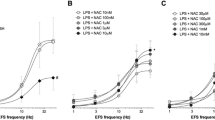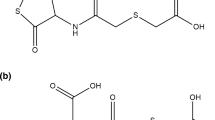Abstract
Objective: We examined the effect of erdosteine (KW-9144), an expectorant, and related compounds on inflammatory cell-derived reactive oxygen species which are involved in airway inflammation.¶Methods: Neutrophils were isolated from peritoneal lavages of casein-injected rats and from peripheral blood of healthy human donors. Eosinophils were isolated from peritoneal lavages of horse serum-injected guinea pigs. These cells were stimulated with phorbol 12-myristate 13-acetate (PMA) and the production of reactive oxygen species was measured with luminol-dependent chemiluminescence (LDCL).¶Results: M1, an active metabolite of erdosteine, significantly inhibited PMA-induced LDCL of the all cell populations with treatment before stimulation. The effects of S-carboxymethylcysteine (S-CMC), ambroxol and N-acetylcysteine (NAC) on the LDCL response were weaker than those of M1. Furthermore, PMA-induced LDCL was decreased by posttreatment with M1.¶Conclusion: These results suggest that M1 (an active metabolite of erdosteine) may exert an antiinflammatory effect by scavenging inflammatory cells-derived reactive oxygen species.
Similar content being viewed by others
Author information
Authors and Affiliations
Additional information
Received 12 June 1998; returned for revision 18 August 1998; accepted by M. J. Parnham 19 January 1999
Rights and permissions
About this article
Cite this article
Miyake, K., Kaise, T., Hosoe, H. et al. The effect of erdosteine and its active metabolite on reactive oxygen species production by inflammatory cells. Inflamm. res. 48, 205–209 (1999). https://doi.org/10.1007/s000110050447
Published:
Issue Date:
DOI: https://doi.org/10.1007/s000110050447




